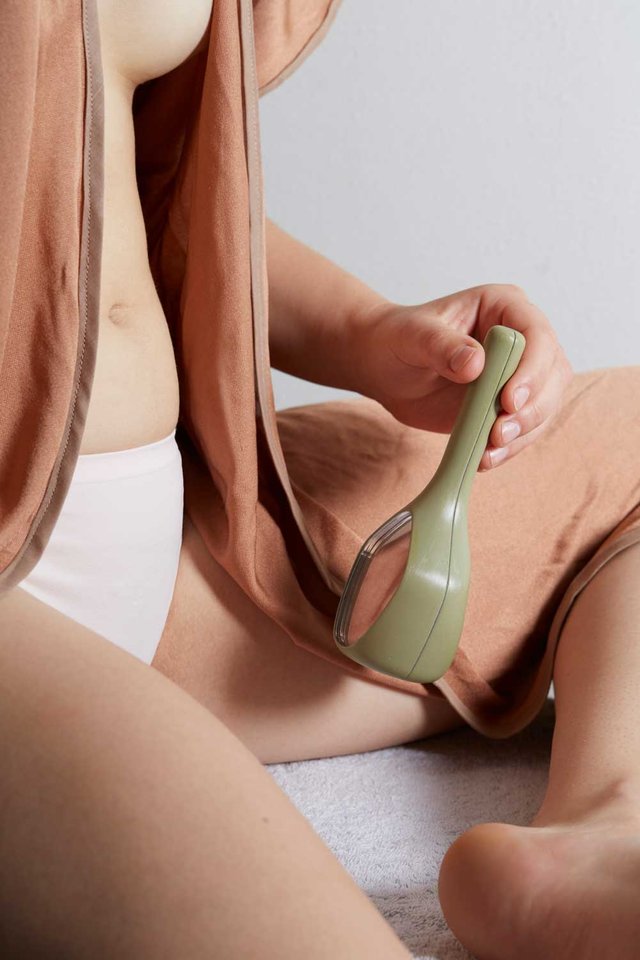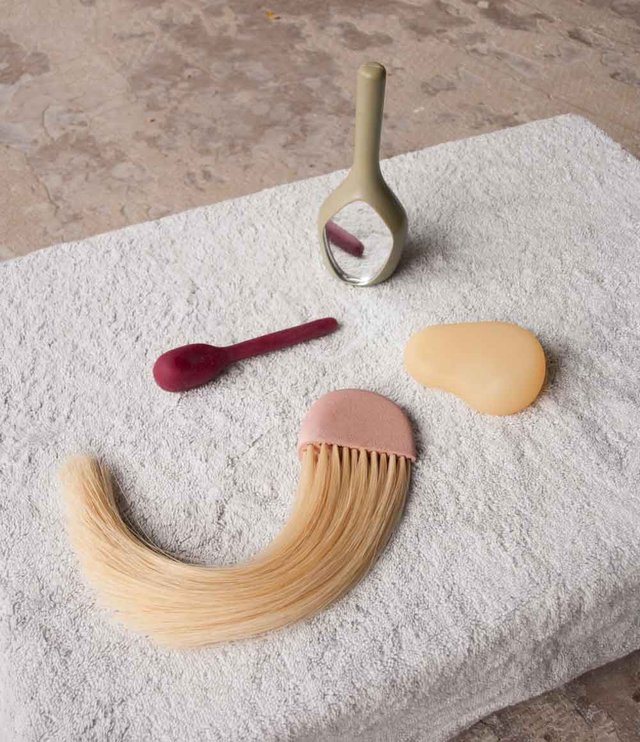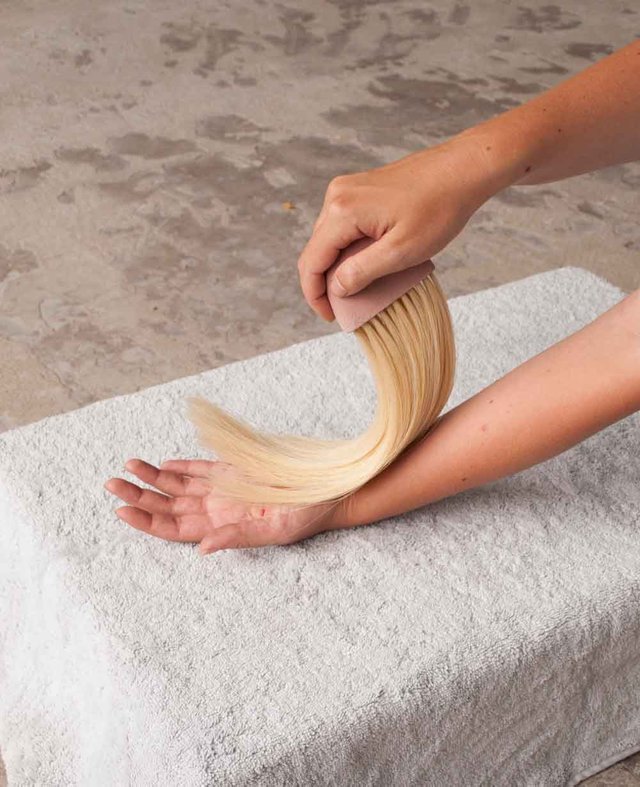Wow, what's that?
I’m not sure when I stumbled across the image, it must have been when I was scrolling through for accounts to follow on Instagram (for the business, I swear). Something very calming and soothing caught my eye.
It was a picture of a lady holding an object that was facing her vulva. Strangely, it was the opposite of perverse and not one bit uncomfortable. She seemed curious, but satiated. It made me feel like I wanted to see what she was seeing too.


That object was a Mirror] by Sexual Healing. It is an object for women to discover their bodies in an intimate, private, yet completely open and honest way. The Mirror is one of four products by Sexual Healing – a rising start up in the #femtech world that began as a research project. For her graduation at Design Academy Eindhoven, one half of Sexual Healing, Nienke Helder, started looking into a new approach for overcoming ‘sexual dysfunctions’ that women can experience after a traumatic experience.
Focusing on finding pleasure
Victims of sexual assault often experience difficulty of a fulfilling sex life. Most of the treatment focuses on the emotional and psychological aspects of the damage. But no one tells you how you can begin to enjoy sex again. The victim is left to navigate future relationships on their own, and work out what their post-trauma triggers and limits are, a doubly traumatic experience as you can imagine.
Nienke says, “The treatment for sexual dysfunction after trauma is a tiring process. You (the patient) run from physical therapist, to sexologist, to gynecologist. It’s a cold, clinical process that doesn’t offer a holistic answer.” On her personal website, speaking about Sexual Healing, she says that a big problem with the treatment of trauma-induced female sexual problems is often clinical, as it focuses on physical issues such as pelvic muscle blockage , and takes penetration as its ultimate goal.
The draining post-trauma journey inspired Nienke to make sexual healing the theme of her graduation project. She poured over medical books and papers (authors of whom she now gets the honour of working with), enlisted the help from other departments in the university and lost sleep over research and countless design drafts. In a matter of months, she showed the fruits of her labour at the Dutch Design Week in October 2017, at a time when the #metoo movement was burgeoning worldwide, and short story short, the crowd went wild.
Completely stepping away from a clinical approach to recovery, Nienke uses research based product design to reprogramme how people deal with physical sensation from different stimulus, accelerating the recovery process and dislodging the association between trauma and intimacy. Each Sexual Healing product is a tool for recovery; most importantly, the tools are non-fleshy, non-phallic and non-penetrative.
The product range


The Mirror, delivering in October, is a mirror that lights up and is specially angled for you to have a good look at your vulva. Very seldom do we look at our vulva the way it actually looks like. Stylised visual respresentations as folds of flower petals in soft dreamy lighting, impersonal line diagrams, close ups in pornography videos distort our view of the most intimate part of us. Nienke tells me that there were groups of women in the 1960s and 1970s who regularly got together to look at their own vulvas together, to foster a better connection with their genitals. I tried to look that up online after our interview, unsurprisingly I could not find information about it. But, I do agree with her, how are we so disconnected from a part of ourselves that is supposed to be our source of feminine energy? And when we lose that, how do we find it back again? In an interview with Dezeen, Nienke says that
“Research shows that if you look at your own vulva, it increases your body positivity a lot. But if you have a trauma, it can be really confronting to look at your own body.”
The Mirror is designed in a way where it shows exactly what you hold in front of it, allowing the user to take their time to explore their bodies.


The Brush, made from horsehair, is meant to help users become comfortable with being touched again. Sexual healing treatments such as somatic sexual wholeness therapy focus on letting go of emotional contractions represented in the body. In his 2014 book The Body Keeps the Score: Brain, Mind, and Body in the Healing of Trauma, psychiatrist Bessel van der Kolk wrote that “When our senses become muffled, we no longer feel fully alive.” Horse hair is used because it is stiffer than other animal hair, but still has fluidity in movement, making it the perfect medium to give a touch that is prickly and high in sensitivity.
Two of the products in the Sexual Healing line focus on biofeedback, and are designed to help the user detect feelings of tension and stress. One is a sensor that is placed on the abdomen, that lights up when the user’s breathing becomes tense, letting the user know to relax. The second is an object that measures the pressure in pelvic floor muscles, that vibrates when the user tenses up, signalling the need to relax. When used with a partner, these objects allow the partner to learn to observe limits and respect, without the user having to give warnings out loud. This is important in slowly rebuilding trust in a relationship, and comfort levels with oneself.
Though created for trauma recovery, I think that the products can also be used by anyone who’s feeling curious to discover a deeper meaning of pleasure.
He refused to share his vegan horse hair
After a wave of overwhelming response from her presentation at the 2017 Dutch Design Week, Nienke gave the people what they wanted, and got to work. In October 2018, Nienke successfully crossed her crowdfunding target of €30,000 to begin producing her line of therapeutic tools.
As a serial entrepreneur myself, I can tell you that a good product or an idea comes along more often than you think, but luck and finding a partner to build that idea with is another thing. And luck Nienke had, in meeting Inge Keltjens through a mutual friend, who would become her co-founder. At their first meeting, they hit it off straightaway; ideas started flowing and plans started cooking, needless to say, it was a great first meeting. However, like two responsible adults, they agreed to take a step back for two weeks before immediately diving into the deep end. A couple of weeks later, they met again, and still had the same passion, excitement and hunger for the project. That’s when they began, as Nienke says, “dating”.
So far, it’s been a good relationship. Inge had never started a products-focused company before, but she’s had valuable experience in other start ups, bringing a complementary set of skills to the partnership.
This is Nienke’s first entrepreneurial foray; she said that she even took a business course at the university for it. I ask her if she finds it difficult to be a businesswoman as a designer, because in my mind, that’s left and right brain work, and people rarely use both sides equally. She tells me that her designer brain is always invested in that product process, where she’s always trying to find the perfect solution for every little problem. Sexual Healing believes that everyone deserves a safe, healthy and fun, pleasurable sex life.
This search for perfection sometimes leads to quirky adventures – one that Nienke says deserves its own podcast even. Nienke and Inge want their products to be accessible to everyone, that means the price of the product should not be too high, but product integrity still dictates that the product should be of high quality and made in a conscious way. The fun is in finding that balance.
Let’s take the Brush for example. Nienke is currently looking for a potential replacement of horse hair, preferably one that is vegan to mimic the touch and texture of horse hair. At the moment, Sexual Healing gets its horse hair from Mongolia, where most violin bow makers go, because horse hair is thicker in cold countries. In her search, she has encountered a violin bow maker who has patented his vegan horse hair whom she has tried to order from but who guards his invention in secrecy, allowing only violin bows to be mailed to him to be strung.
See? Podcast.
Putting back what was taken away
I think that detail in the products is telling of who Nienke and Inge are, and what Sexual Healing is. From the name (which of course the founders were told many times they should change) of the brand, to the soft ergonomic lines of the products, to their colours and brand pictures, the pair has managed to be so respectful and delicate in their approach to treatment, yet at the same time, so progressive, intelligent, and caring.
I strongly believe that a brand is an extension of the owner, the owner cares for the brand the the same way she nurtures a child. Then somewhere, along the way, the brand begins to somehow sync with the owner, and the resulting product just seems right.
That’s the feeling I get with Nienke, that the products are personal, that a piece of her is in them, that the product intentions come from a place of wanting to heal and teach. In a sensitive space, Sexual Healing has beautifully put touch and intimacy centrestage, using the very things that were taken away to allow recovery and restoration of.